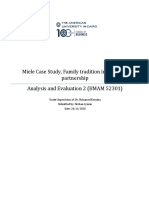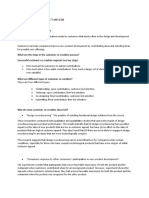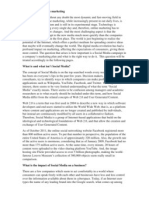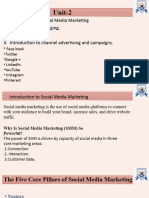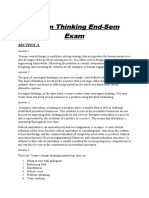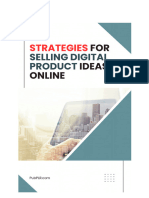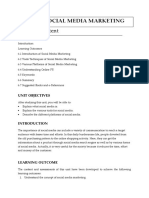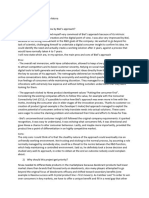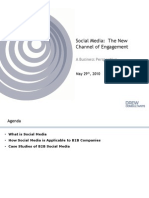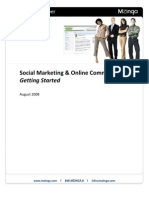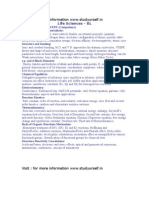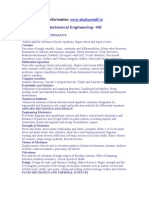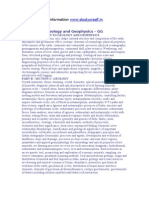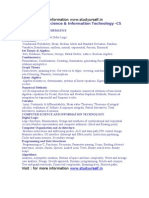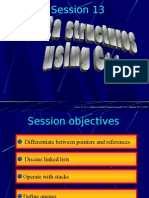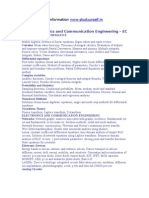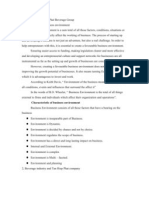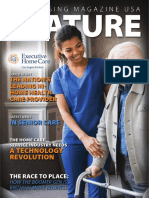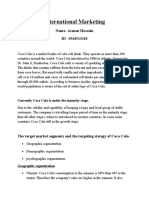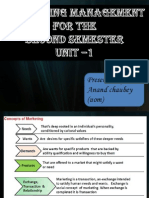Open Innovation Marketing: A Case Study
Open Innovation Marketing: A Case Study
Uploaded by
studyurselfCopyright:
Available Formats
Open Innovation Marketing: A Case Study
Open Innovation Marketing: A Case Study
Uploaded by
studyurselfOriginal Description:
Original Title
Copyright
Available Formats
Share this document
Did you find this document useful?
Is this content inappropriate?
Copyright:
Available Formats
Open Innovation Marketing: A Case Study
Open Innovation Marketing: A Case Study
Uploaded by
studyurselfCopyright:
Available Formats
Open Innovation Marketing
A Case Study
Catharina van Delden , Nancy Wnderlich innosabi GbR Sendlinger Strae 7 80331 Mnchen catharina.vandelden@innosabi.com Technische Universitt Mnchen Lehrstuhl fr Dienstleistungs- und Technologiemarketing Arcisstr. 21 80333 Mnchen nancy.wuenderlich@wi.tum.de
Abstract: Social networks and communities like facebook and myspace gain increasing importance in peoples everyday lives. Companies start to see these platforms as a chance for communicating to an attractive target group and deriving innovation ideas from this group. Yet, methods and tools to efficiently initiate and use open innovation projects in these environments are limited. This article explores open innovation projects as a new method for systematically utilizing the creative potential of social community users and turning them into brand ambassadors.
1 Open Innovation Marketing
For open innovation as a competitive strategy, rather than a marketing tool, customers are seen as great source for creating innovative products and services. [Ch06] This trend has been a buzz-topic in marketing as well as innovation management in recent literature. Another buzz topic is social media, therein especially social networks like facebook, and the marketing therein [Ro05]. This article discusses how the two trends open innovation and social network marketing can be combined. It shall answer the question of how companies can reach consumers where they spend their time as well as how to create viral effects using open innovation projects. These topics will be discussed using the case study of the facebook application prototype unserAller. The open innovation enabler innosabi has established this new platform in order to enable communication about new products between users and companies inside the social network facebook. It can be seen as a demonstration of a new service to enable open innovation and leverage its marketing potential.
973
1.1 Basic Problem innosabi observed that consumers are not longer willing to buy what is offered at the market but increasingly want to influence and participate in companies decisions. This can for example be seen in the organic and fair-trade movement, where consumer do not buy a product due to its concrete features, but because they want to send the industry a message, like e.g. treat the environment and your suppliers well. At the same time it becomes more difficult for companies to reach consumers between 20 and 35 years. This target group often does not trust in traditional advertising any more and uses methods to avoid advertising, e.g. online advertising-blockers or digital video recorders. Yet they spend an increasing amount of time in social networks like facebook, XING or myspace. These networks already created a change in consumer behavior [Ni09]. Thus companies start to see social networks as a chance for interaction and innovation contrary to the unidirectional communication pattern of traditional marketing tools.
2 The Internet Platform unserAller
unserAller is a platform where companies can collaboratively create products with its users in a standardized process that aims at creating brand ambassadors. It has been designed as a facebook application, since elements of an effective user innovation process are in place within facebook: It encourages exchange and reactivity [FD09].
Picture 1: Interlink between facebook and the application unserAller
2.1 Underlying Ideas unserAller standardizes the process of product development for line extensions and render it accessible for companies with a focus on the consumer goods sector. This communication has the goal of creating brand ambassadors in social networks.
974
The platform shall enable community development or social product development. Product features shall be the result of community agreement and the final result is a product that the whole community supports as brand ambassadors. This process of social product development inside facebook is especially of interest to companies in the sector of fast moving consumer goods, since the majority people have a need and opinion towards their products. In order to show that producers are taking the uttered opinions and suggestions seriously, the project partners need to commit on manufacturing and marketing of the winning product. These products will be available in the unserAller online shop, as well as the manufacturers distribution network. 2.2 Functionality The main sections of the unserAller platform frontend are: 1.) Homepage with introductory video 2.) Project overview, displaying all upcoming, active and archived projects 3.) Project pages, consisting of project blog suggestion/discussion pages and voting pages 4) Shop, where the developed products are sold
Picture 2: Screenshots of the unserAller platform frontend
unserAller makes use of facebooks viral tools that are triggered by functionalities like wall-posts. Therefore unserAller users can inform their friends about certain events with posts on their own facebook wall. E.g. a suggestion posted for a project could be posted on a users wall in order to ask friends for support and comments. 2.3 Product Development Process The product development process on unserAller is structured in five phases and aims at developing line extensions in existing product categories.
975
Picture 3: The unserAller product development process
These five phases, are occasion, product design, material, name and packaging. Each phase can be split in several sub-phases or left out. This allows very different products to be developed on the unserAller platform and yet standardize the product development process. In each phase, consumers first post suggestions and eventually photos that can be discussed, and further developed in the community. Suggestions are displayed anonymously which ensures that the best suggestion and not a person wins. Users can assign hearts to suggestions they like. In the voting step of each phase users have seven votes each that can be distributed amongst all suggestions, with three votes maximum for a single suggestion. The voting step determines the final result of a phase, which provides the basis for the following phase. During suggestion steps, user innovation toolkits [HK02] are sent to the most active partcipants in order to increase motivation and fun in the product development. These packages contain materials necessary to prototype the products to be developed and also some materials that are not expected in order to trigger the users creativity. People can try at home what they like best and post their suggestions and photos. For graphics based challenges user innovation toolkits [HK02] are posted in form of downloadable pdf-files, so that users can visualize their ideas, using only glue and scissors. The main tool for transmitting information are short videos, since web 2.0 platforms are increasingly making use of videos and thus users get used to watch instead of read. 2.4 Incentive System Participants collect points for their participation. Points can be gained for all main activities on the platform like posting a suggestion, winning a phase, receiving a heart from others or linking unserAller on other websites. The points can be traded into rebates for products or even into cash depending on the project. This incentive system aims at increasing users intrinsic motivation since the one with the highest benefit is not the winner of a challenge but the one that has contributed most to the process of finding the final product concept.
976
2.5 Vision innosabis vision is that on the long run, a product that is created with the unserAller community shall be recognized as an especially good product so that created by community becomes a sign of quality, especially of user friendliness and developed exactly to the users needs. 2.6 First Projects The unserAller platform launched on the 1st of June 2010. Since then two reference projects have been conducted. In the first project a chutney with the restaurant der Gesellschaftsraum was created. The winning chutney peach and onions is now offered on the restaurants menu. This project served mainly as a technical test of the features and only the material phase was conducted. 50 prototyping packages were sent out and the 50 most active participants received the final chutney. 359 facebook users participated in the project and posted 128 suggestions for a new chutney. In the second project a mustard will be developed collaboratively. It is of a larger scale and consists of three phases: Occasion, material and packaging. By the time this paper is written, only the results of the first phase are decided: The new mustard product will be a dip. The finally created mustard will be available from the mustard manufacturer MariSenf.
3 Outlook for Research
From a research perspective the open innovation projects lead to interesting questions in the field of services marketing that future research should address. As the open innovation project is mainly dependent on the involvement of the participants and the quality of their inputs it is crucial for providers of open innovation projects to get insights into the characteristics and attitudes of their participants. Especially, the following research questions should be addressed: 1. What characteristics describe open innovation project participants? Which users are the most valuable ones for increasing the success of the open innovation process? In how far is the group of users suitable to bring in the wishes and preferences of the potential customer group in the development process of new products and services? What drives community and social network users such as facebook users to participate in open innovation projects? What are intrinsic and extrinsic motivation factors? Which incentives should be set out to attract the most valuable users?
2.
977
3.
Are open innovation projects efficient tools for managers to communicate and innovate with their customers? What defines the quality of the open innovation project? In how far does the satisfaction of the participants relate to the quality and success of the innovation process outcome?
Answers to these questions would not only help academics to understand the complex interplay between participants in the highly collaborative open innovation process, it would help open innovation project managers to sample the group of participants and to improve the process design to gain better outcomes of the project. Starting with the mustard project the open innovation projects by innosabi are in the focus of scientific empirical studies on the characteristics, attitudes, and performance of the participants of the project. The results of the studies are expected to provide answers to the before mentioned research questions.
List of Literature
[Ch06] Chesbrough, H.: Open Innovation. Harvard business school press, Boston, 2006. [FD09] Ferebee, S.; Davis, J.: The Innovation Architectures of Facebook. In (Ozok, A., Zaphiris, P., Eds.): Online Communities and Social Computing: Third annual conference, OCSC 2009, Held as part of HCI International 2009, San Diego, CA, USA 2009. SpringerVerlag, Berlin Heidelberg, 2009; pp. 322-325. [HK02] Hippel, von, E.; Katz, R.: Shifting Innovation to Users via Toolkits. Management Science, Vol. 48, No. 7, July 2002; pp. 821-833. [Ni09] The Nielsen Company: Global Faces and Networked Places. A Nielsen Report on Social Networkings New Global Footprint. www.nielsen.com, 2009. [Ro05] Rosen, E.: The Anatomy of Buzz: How to Create Word of Mouth Marketing. Broadway Business, New York, 2005.
Acknowledgements
The authors of this paper and innosabi thank the Peter-Pribilla-Stiftung for the generous financial support of the project unserAller. Also we thank the European Social Fond as well as the Bundesministerium fr Wirtschaft und Technologie in Germany for their funding.
978
You might also like
- Thøger Christensen - 2002 - Corporate Communication The Challenge of TransparDocument8 pagesThøger Christensen - 2002 - Corporate Communication The Challenge of TransparjazzloveyNo ratings yet
- DIGITAL MEDIA Notes Till SEMDocument66 pagesDIGITAL MEDIA Notes Till SEMmehtarspiderNo ratings yet
- The Social Media RevolutionDocument4 pagesThe Social Media Revolutionmarquez_barcena100% (1)
- Strategic Plan For Coffee eDocument14 pagesStrategic Plan For Coffee eCarla Flor LosiñadaNo ratings yet
- Nivea (A)Document2 pagesNivea (A)sukriti guptaNo ratings yet
- Updatred FinDocument60 pagesUpdatred FinAshutoshSharmaNo ratings yet
- Miele Case Study - Norhan AymanDocument3 pagesMiele Case Study - Norhan AymanNorhan Ayman0% (1)
- Colgate (Brand Management)Document18 pagesColgate (Brand Management)Abhishek PramanikNo ratings yet
- Midterm PDFDocument4 pagesMidterm PDF孙美儿No ratings yet
- Nguyen Khanh Huyen-HS176177-MKT1704 1.: What Is Customer Co-Creation?Document4 pagesNguyen Khanh Huyen-HS176177-MKT1704 1.: What Is Customer Co-Creation?Hoang Minh Son (K16HL)No ratings yet
- Social Media Marketing: April 2019Document3 pagesSocial Media Marketing: April 2019NoraNo ratings yet
- Analiza SwotDocument31 pagesAnaliza SwotOana AlexandraNo ratings yet
- Social Media ProjectDocument5 pagesSocial Media ProjectAlexa SferleNo ratings yet
- Socia MediaDocument83 pagesSocia MediamaxcrezyNo ratings yet
- Research Paper On Social Media Marketing: Submitted By:-Submitted ToDocument25 pagesResearch Paper On Social Media Marketing: Submitted By:-Submitted ToMalvika MisraNo ratings yet
- Social Media and Its Effects As A Marketing Communication ToolDocument42 pagesSocial Media and Its Effects As A Marketing Communication ToolXion RahmanNo ratings yet
- Medical Project Report HRDocument51 pagesMedical Project Report HRAagam JainNo ratings yet
- Unit 2 - Digital MarketingDocument39 pagesUnit 2 - Digital MarketingRahul KumarNo ratings yet
- Social Media MarketingDocument6 pagesSocial Media MarketingUpadhayayAnkurNo ratings yet
- Research Paper On Social Media Marketing: Submitted By:-Submitted ToDocument25 pagesResearch Paper On Social Media Marketing: Submitted By:-Submitted ToMalvika MisraNo ratings yet
- Trends of Social Platforms.Document4 pagesTrends of Social Platforms.Aditya DasNo ratings yet
- Research Proposal IitmDocument24 pagesResearch Proposal Iitmagrawalbhaskar51No ratings yet
- Project Report Bba 3RD YrDocument37 pagesProject Report Bba 3RD YrShashank AgrawalNo ratings yet
- Design Thinking End SemDocument6 pagesDesign Thinking End SemJAcob AbrahamNo ratings yet
- Research Paper Chap12Document25 pagesResearch Paper Chap12Arlene LumagbasNo ratings yet
- Digital Marketing (7. Social Media Marketing)Document102 pagesDigital Marketing (7. Social Media Marketing)nanekaraditya06100% (1)
- Book1 - Strategies For Selling Digital Product Ideas OnlineDocument20 pagesBook1 - Strategies For Selling Digital Product Ideas Onlineaspect.hj.lNo ratings yet
- Executive SummaryDocument53 pagesExecutive SummaryAarti Ahuja100% (1)
- Unit 6 OMBE 307 - Digital MarketingDocument9 pagesUnit 6 OMBE 307 - Digital MarketingJibandaanPharmacy Doctors ChamberNo ratings yet
- 04 Module II. Facebook Twitter Google Linkedin 1Document8 pages04 Module II. Facebook Twitter Google Linkedin 1Mr NasrullahNo ratings yet
- Rehan Ahmad - Social Media ProjectDocument51 pagesRehan Ahmad - Social Media Projectmdshabbir3600No ratings yet
- 2-2 Innovation Management (IM) - Calilap-3Document4 pages2-2 Innovation Management (IM) - Calilap-3Reciel MaingatNo ratings yet
- Achieving Marketing 4.0 During The New Normal EraDocument10 pagesAchieving Marketing 4.0 During The New Normal EraShubhangi KesharwaniNo ratings yet
- 22.04.959 Jurnal EprocDocument7 pages22.04.959 Jurnal Eprochydoni2007No ratings yet
- 1) Explain The Various Stages of NPD: New Product Development StagesDocument90 pages1) Explain The Various Stages of NPD: New Product Development StagesMayurNo ratings yet
- Perception Towards Social Media Marketing Project PDFDocument49 pagesPerception Towards Social Media Marketing Project PDFalifahadmz04No ratings yet
- Social Media Marketing: Emerging Concepts and Applications 1st Edition Githa Heggde 2024 Scribd DownloadDocument52 pagesSocial Media Marketing: Emerging Concepts and Applications 1st Edition Githa Heggde 2024 Scribd Downloadsatafosala100% (3)
- Digital MarketingDocument31 pagesDigital MarketingSharath Kumar50% (2)
- SampleDocument30 pagesSampleNigar QurbanovaNo ratings yet
- Bhushan Final ProjectDocument69 pagesBhushan Final Projectbhushan3501No ratings yet
- Analysis of Growth Strategies in Social Media The Instagram Use Case FINALDocument8 pagesAnalysis of Growth Strategies in Social Media The Instagram Use Case FINALJéssica Gomes de AndradeNo ratings yet
- Group-5 Research (Autorecovered)Document14 pagesGroup-5 Research (Autorecovered)Ronnie LindioNo ratings yet
- MORRA - Edoardo NiveaDocument3 pagesMORRA - Edoardo NiveavEdoardo MorraNo ratings yet
- Intro To Social Media For Businesses - DCLLC 05.29.10Document15 pagesIntro To Social Media For Businesses - DCLLC 05.29.10Eric A SiegmannNo ratings yet
- HumanCenteredDesign PDFDocument7 pagesHumanCenteredDesign PDFVaibhav KaushikNo ratings yet
- Dissertation Proposal On Social MediaDocument7 pagesDissertation Proposal On Social MediaPaperWritersOnlineCanada100% (2)
- Chapter One: 1.1 Background of The StudyDocument14 pagesChapter One: 1.1 Background of The Studypercepshan100% (1)
- Social Media MarketingDocument85 pagesSocial Media MarketingManohar GuptaNo ratings yet
- FacebookDocument3 pagesFacebookAshish RamtekeNo ratings yet
- PR Copy IDocument35 pagesPR Copy IIrah CabanlitNo ratings yet
- 015 and 016Document10 pages015 and 016NET ZONENo ratings yet
- UNIT 6: Innovation MethodsDocument2 pagesUNIT 6: Innovation MethodsErika BernardinoNo ratings yet
- T N W NotesDocument4 pagesT N W NotesridhimaNo ratings yet
- Perception Towards Social Media Marketing ProjectDocument50 pagesPerception Towards Social Media Marketing Projectalifahadmz04No ratings yet
- Rethinking Business Strategy For A Hyper-Connected WorldDocument38 pagesRethinking Business Strategy For A Hyper-Connected WorldAlvaro RojoNo ratings yet
- Unit-4,5: Product Development Process: Phase 0. PlanningDocument6 pagesUnit-4,5: Product Development Process: Phase 0. PlanningAchal SharmaNo ratings yet
- Measuring The Degree of Corporate Social Media Use PDFDocument19 pagesMeasuring The Degree of Corporate Social Media Use PDFsocialmedia3No ratings yet
- Lecture 05 - Social MediaDocument30 pagesLecture 05 - Social MediaharshidbvNo ratings yet
- A Study On Social Media For Innovative Marketing StrategiesDocument83 pagesA Study On Social Media For Innovative Marketing Strategiesankur kumarNo ratings yet
- 16 Outofhome-Innovations-In-India-In-The-Recent-PastDocument92 pages16 Outofhome-Innovations-In-India-In-The-Recent-Pastdhrruv kkNo ratings yet
- Mzingawp Social Media MarketersDocument12 pagesMzingawp Social Media MarketersJuliana GuerraNo ratings yet
- Group-3 Presentation Pur - Com.Document11 pagesGroup-3 Presentation Pur - Com.Melchor CristobalNo ratings yet
- Digital Media EssayDocument11 pagesDigital Media Essayhung.dngxNo ratings yet
- Anatomic Therapy TamilDocument325 pagesAnatomic Therapy TamilstudyurselfNo ratings yet
- Channel List EngDocument8 pagesChannel List Engstudyurself0% (1)
- 2ksmkt Wwe2k17 Ps4 Online Manual v7Document13 pages2ksmkt Wwe2k17 Ps4 Online Manual v7ahmad ranaNo ratings yet
- TopologiaDocument373 pagesTopologiarafarequena8No ratings yet
- Project Title: Sos Project Guide: J. MohabathDocument3 pagesProject Title: Sos Project Guide: J. MohabathstudyurselfNo ratings yet
- B Tech Supplementary Exam Timetable 2013Document14 pagesB Tech Supplementary Exam Timetable 2013studyurselfNo ratings yet
- EX - NO:1 On-Line Ticket Reservation DateDocument12 pagesEX - NO:1 On-Line Ticket Reservation DatestudyurselfNo ratings yet
- Wbps AbsDocument1 pageWbps AbsstudyurselfNo ratings yet
- Telecom Business Management SystemDocument7 pagesTelecom Business Management SystemstudyurselfNo ratings yet
- GATE MathematicsDocument2 pagesGATE MathematicsstudyurselfNo ratings yet
- Onenews Premium Setup GuideDocument9 pagesOnenews Premium Setup GuidestudyurselfNo ratings yet
- GATE Life SciencesDocument6 pagesGATE Life SciencesstudyurselfNo ratings yet
- GATE Mechanical EngineeringDocument3 pagesGATE Mechanical EngineeringstudyurselfNo ratings yet
- GATE Chemical EngineeringDocument2 pagesGATE Chemical Engineeringstudyurself0% (1)
- GATE Geology GeophysicsDocument3 pagesGATE Geology GeophysicsstudyurselfNo ratings yet
- GATE Engineering SciencesDocument6 pagesGATE Engineering SciencesstudyurselfNo ratings yet
- GATE Computer ScienceDocument2 pagesGATE Computer SciencestudyurselfNo ratings yet
- Session 13Document48 pagesSession 13studyurselfNo ratings yet
- GATE Agricultural EngineeringDocument3 pagesGATE Agricultural EngineeringstudyurselfNo ratings yet
- Gate EceDocument3 pagesGate EcestudyurselfNo ratings yet
- Influencer Marketing Focusing On Tiktok PlatformDocument11 pagesInfluencer Marketing Focusing On Tiktok PlatformRein MalabanaNo ratings yet
- The Relationship Between Price Paid and Hotel Review RatingsDocument10 pagesThe Relationship Between Price Paid and Hotel Review Ratingstkxkq2No ratings yet
- BS Lesson 1 & 2 (Ch1 & Ch2) StuDocument92 pagesBS Lesson 1 & 2 (Ch1 & Ch2) StuFeu D'artifice De OctobreNo ratings yet
- What We Can Learn From "Purpose Driven Branding"Document12 pagesWhat We Can Learn From "Purpose Driven Branding"Shantanu SenguptaNo ratings yet
- E DetailingDocument50 pagesE DetailingParul GoyalNo ratings yet
- Contagious Radar 2024Document37 pagesContagious Radar 2024lanakharebovaaNo ratings yet
- Rural Marketing Question Bank 2011Document4 pagesRural Marketing Question Bank 2011Vijay KumarNo ratings yet
- Rijuta RichiDocument3 pagesRijuta RichiMkgt HemaautomationNo ratings yet
- Overview of THPDocument3 pagesOverview of THPHong Anh NguyenNo ratings yet
- Franchising USA 2022-09 Senior Care SpecialDocument19 pagesFranchising USA 2022-09 Senior Care SpecialKelsie JacksonNo ratings yet
- Operation ManagementDocument4 pagesOperation Managementbishop168No ratings yet
- IMC Group AssignmentDocument26 pagesIMC Group AssignmentHarshNo ratings yet
- Digital Marketing and Brand ManagementDocument11 pagesDigital Marketing and Brand ManagementNguyen NguyenNo ratings yet
- D&AD Student Awards 2012 Create The Packaging For A 21st Century Scotch WhiskyDocument4 pagesD&AD Student Awards 2012 Create The Packaging For A 21st Century Scotch WhiskyAmy Cecilia LeighNo ratings yet
- KFC's Vegetarian Voyage: A Consumer Insights Perspectives in Australia.Document22 pagesKFC's Vegetarian Voyage: A Consumer Insights Perspectives in Australia.aronno_du185No ratings yet
- Nachiket Waghmare: Executive Profile Core CompetenciesDocument2 pagesNachiket Waghmare: Executive Profile Core CompetenciesAakash SharmaNo ratings yet
- Business Strategy: Kellogg's CompanyDocument14 pagesBusiness Strategy: Kellogg's CompanyRAJARSHI ChakrabortyNo ratings yet
- Rahul Sharma CVDocument4 pagesRahul Sharma CVexpanpartnersNo ratings yet
- Trek Logo Standards 2001Document7 pagesTrek Logo Standards 2001dph9zp7mfbNo ratings yet
- International MarketingDocument4 pagesInternational MarketingArman HossainNo ratings yet
- AdvertisementDocument9 pagesAdvertisementAman DhingraNo ratings yet
- IBAT Case AnalysisDocument6 pagesIBAT Case AnalysisMary Ann RosalejosNo ratings yet
- Marketing MGTDocument382 pagesMarketing MGTchaubeyanand358100% (1)
- Business Proposal Letter To ClientDocument3 pagesBusiness Proposal Letter To ClientharshitNo ratings yet
- Anwar Building Materials DeckDocument69 pagesAnwar Building Materials DeckanwarindustrialcementsheetNo ratings yet
- Anaysis of AdvertisementsDocument21 pagesAnaysis of AdvertisementsbenusagardubeyNo ratings yet






